Do-it-yourself air heating: everything about air heating systems
Practice shows that the vast majority of homeowners living in Russia choose liquid coolant systems for heating.Perhaps at one time this was indeed the most practical option.
But technology is developing, and more and more efficient designs are appearing. Such as various air heating systems that allow you to quickly and economically heat any room.
The content of the article:
Operating principle and types of air heating
You need to know that there are two different types air type heating, each of which can be used in practice.
The first is implemented in systems with a heater. It is essentially similar to heating with a liquid coolant, with the difference that heated air is used instead of liquid. A duct heater heats the air, which moves through special pipes into the heated rooms.
Filled with hot air air ducts heat the room. Such systems are rarely used today, since the channels are inevitably damaged during operation. As a result of alternating heating and cooling, the air ducts either expand or contract, causing the joints to weaken and cracks to appear in the walls.
This leads to disruption of the air distribution process and, as a result, to uneven heating of the premises, which is undesirable. An open air heating system is considered more practical.
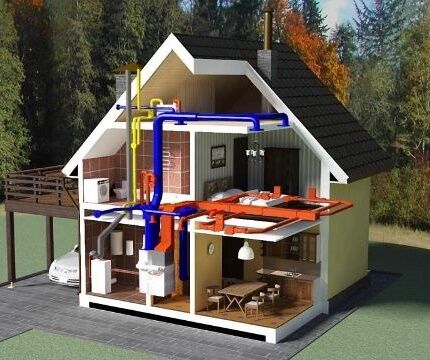
The principle of its operation is as follows. The heat generator heats the air, which is supplied through a pipe system to the heated rooms. Here it goes outside and mixes with the air present in the room, thereby increasing the temperature in it.
The cooled air is directed downwards, where it enters special pipes and through them again enters the heat generator for heating.
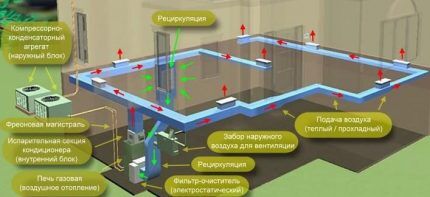
Based on the radius of action, heated air heating systems are divided into local and central. The first includes circuits designed to serve one object (cottage, room, two or more adjacent premises), the second includes apartment buildings, public and industrial facilities
All systems are divided into schemes with complete recirculation of the coolant, with partial recirculation and direct flow.

All central systems belong to the direct-flow category.For them, the air coolant is heated in the heating center of the building and then supplied to the premises through air distributors. Central circuits are only channel ones.
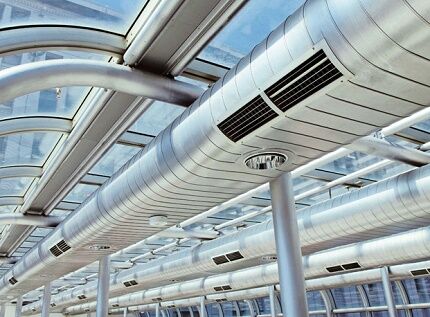
Central air heating is installed in industries that produce or use flammable, toxic, explosive, etc. products. substances. In the arrangement of country houses, this type is used if it is necessary to transport heated air over a long distance.
Organizing a scheme for private owners is impractical due to the need to use powerful ventilation equipment.
Current types of system
Today, there are several types of air heating, each of which should be familiarized with everyone who is going to install a similar structure in their home. Systems can be classified according to different criteria. Let's start with the method of air circulation. Based on this, two main types can be distinguished.
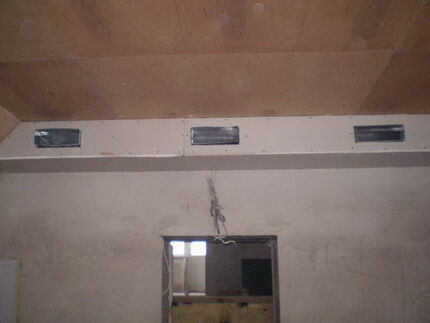
Natural air circulation system
To operate this design, the property of hot air to rise upward is used. The heated gas rises into the rooms through air ducts laid in the walls and exits outside through holes located in the ceiling of the room.
The main advantage of such systems is their low cost, since there is no need to spend money on additional equipment.
However, there are quite a few significant shortcomings. First of all, the speed at which air rises through the pipes is low. This way the room will be heated for a long time.
In addition, when using heating with natural circulation, it is most often necessary to place the air duct outlets in the upper part of the room, which may not always be convenient.
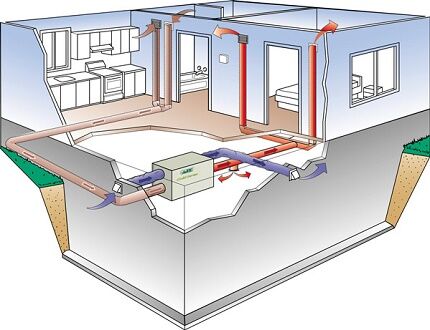
Forced air design
Such systems must be equipped with a ventilation unit, the power of which depends on the length and number of air ducts. Large areas will require the installation of several devices. The main task of the equipment is to move heated air through air ducts to heated rooms. As a result, its speed increases, and rooms are heated in the shortest possible time.
Despite the need to install fans, such systems are ultimately more economical. Due to the increased air exchange rate, the system sucks cooled air of a sufficiently high temperature from the room.
It simply does not have time to cool down to the minimum values. Reheating it requires much less energy, resulting in significant overall cost savings.
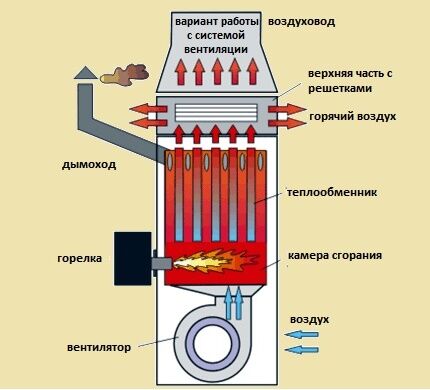
Depending on the location of the air ducts, heating systems can also be divided into two groups.
Underfloor air heating
A distinctive feature of the system is the air duct outlets embedded in the floor or built into the baseboards. The result is the most efficient distribution of heated air entering the lower part of the room.
Warm air tends upward, as a result of which the air masses are mixed quite quickly and the room warms up faster.
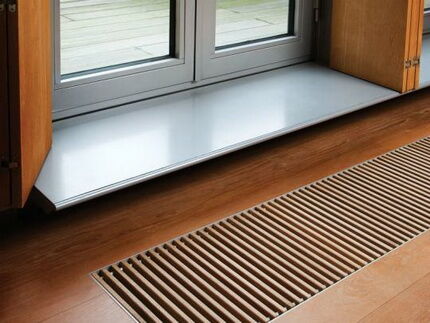
Suspended air systems
The scheme assumes the presence of air ducts built into the ceilings or walls, whose outlets are located strictly in the upper part of the room. Most often under the ceiling. As an option, there are suspended air ducts with the same terminals.
It must be admitted that such systems are generally less aesthetically pleasing than their floor counterparts. Although there are ways to decorate and disguise air ducts.
In addition, the use of a floor system assumes that the temperature of the air located below will be the highest. The upper half of the room will be a little colder.
Doctors consider this temperature distribution to be the best for humans. In addition, air duct outlets built into the floor or baseboard are almost invisible, which significantly improves the appearance of the room.
The main disadvantage of suspended systems, which is especially undesirable for private houses, is considered to be a lower air temperature near the floor than at the top. The heated air heats the upper part of the room faster and more intensely, while the floor remains cool. That is why such systems are either rarely used in residential buildings or are combined with some other heating system.
According to the method of heat exchange, all air heating systems are divided into three types.
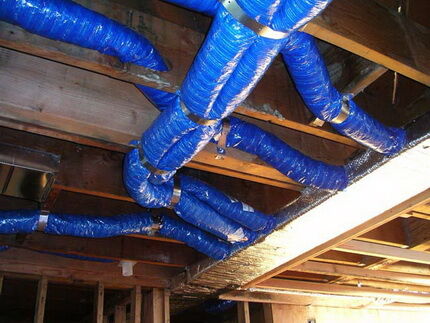
Direct-flow heating circuit
The direct-flow option has been known for several centuries. The ancient Romans and medieval Russians used similar systems for heating. The operating principle of direct-flow heating is very simple. At the bottom of the building, most often in the basement, a heating device is installed that heats the air entering it. Next, the heated air masses enter the heated rooms through air ducts.
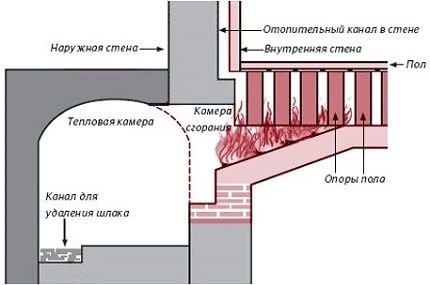
After which, after passing through them, they are taken out into the street. Thus, thermal energy is spent not only on heating the room, but also literally on “heating the street.” This is why the direct-flow system is considered the least efficient of all and has the highest initial and operating costs.
The main advantage of this design is complete ventilation of heated rooms. It is used only when a volume of ventilation is required equal to the volume of air masses required for heating. Such a condition may be mandatory when operating premises where they work with explosive, hazardous to health or unpleasant-smelling substances.
For home heating, a direct-flow system is used extremely rarely. If for some reason it is necessary to install it, it is worth installing equipment for additional recovery.
This could be an air exchanger, which will allow you to use part of the heat of the air coming out to heat the supply air masses. In this way, it will be possible to slightly reduce operating costs.
Recirculation heating system
The room is heated using a closed cycle. First, the air is heated by a heat generator and moves through pipes into the room.
Here it gradually cools down and begins to fall towards the floor, where the entrances of the exhaust air ducts are located. Once inside, the cooled air moves to the heat generator, where it is heated again and the cycle repeats.
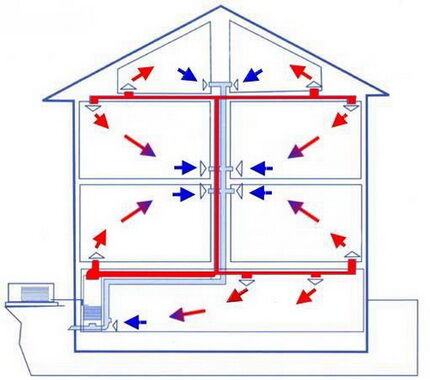
This scheme is the most efficient, since heat loss is practically eliminated. Its main disadvantage is the low quality of air that circulates inside heated rooms.
Therefore, it is more often used for heating non-residential rooms or warehouses. If such a scheme is used in residential buildings, the installation of additional equipment for ionization and air humidification is mandatory.
Scheme with partial recirculation
This system makes it possible to eliminate the main disadvantage of the recirculation scheme - low air quality. To do this, it includes additional ventilation equipment, which takes in outside air and mixes it in the right proportions with the air masses circulating indoors. Everything else is similar to the full recirculation scheme.
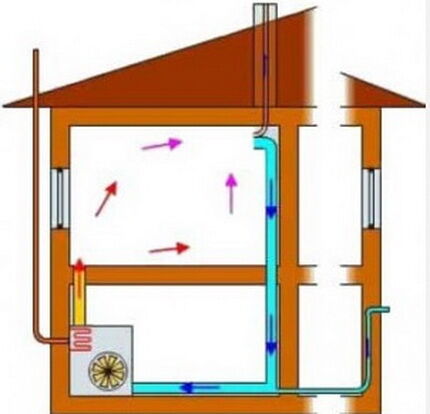
The system is characterized by maximum flexibility and is capable of operating in several modes: as ventilation, as heating or as a combined heating and ventilation system.
At the same time, it can take in any required amount of air, heat it or even cool it to the desired temperature. A scheme with partial recirculation is considered optimal for arranging air heating in a private house.
Arguments for choosing an air system
Compared to conventional systems operating on liquid coolant, aerial diagrams have significant advantages. Let's take a closer look at them.
- High efficiency of air systems. The productivity of air heating circuits reaches about 90%.
- Possibility to turn off/on equipment at any time of the year. Work interruption is possible even in the most severe winter cold. This means that a switched-off heating system will not become unusable at low temperatures, which, for example, is inevitable for water heating. You can put it into operation at any time.
- Low operating cost of air heating. There is no need to purchase and install quite expensive equipment: shut-off valves, adapters, radiators, pipes, etc.
- Possibility of combining heating and air conditioning systems. The result of the combination allows you to maintain a comfortable temperature in the building in any season.
- Low system inertia. This ensures extremely fast heating of the premises.
- Possibility of installing additional equipment, which is used to maintain an optimal microclimate.These can be ionizers, humidifiers, sterilizers and the like. Thanks to this, you can choose a combination of devices and filters that exactly matches the needs of the residents of the house.
- Maximum uniform heating of rooms without local heating zones. These problem areas are usually located near radiators and furnaces. Due to this, it is possible to prevent temperature changes and their consequence - unwanted condensation of water vapor.
- Versatility. Air heating can be used to heat rooms of any size, located on any floor.
The system also has some disadvantages. Among the most significant, it is worth noting the energy dependence of the structure. Thus, when there is a power outage, the heating stops functioning, which is especially noticeable in areas with intermittent power supplies. In addition, the system requires frequent maintenance and monitoring.
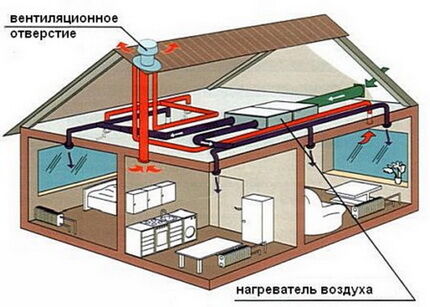
Another negative feature of air heating is that the installation of the structure must be carried out during the construction process. The installed system is not subject to modernization and practically does not change its operational characteristics.
If necessary, it is possible to install air heating in a constructed building, but in this case only suspended air ducts are used, which is not aesthetically pleasing and is not always effective.
Basic elements of the heating system
Before you set up air heating with your own hands, you need to get acquainted with the elements of which it consists.
Air heating devices
The main task of the equipment is to heat the air entering inside to the desired temperature. Almost all known heat sources can be used for this.
Depending on the type of heating device, air masses are either passed through a heat exchanger with hot steam, water, etc., or heated directly inside the heater.

In practice, four types of structures are used as heat generators for air heating systems:
- Direct heating fuel systems. In them, the air is heated from the heat obtained from the combustion of any fuel. This type includes coal, gas, diesel, pellet and other heaters.
- Direct heating electrical equipment. It is a powerful fan heater that is connected to the air ducts.
- Indirect heating devices. It is assumed that there is a heat exchanger in which hot liquid circulates. The latter can be heated in any way: using a wood stove or any other heating device. As an option, you can consider connecting coolant from a centralized heating system.
- Combined design. It consists of two, sometimes three systems of different types, combined into a common design. The most effective and practical option is obtained by combining an electrical and liquid system.
The last option is considered the most successful, since such equipment will be able to provide the house with heat even in the event of a power outage or problems with fuel. However, for obvious reasons, such devices are more expensive. Spending money on them is not always justified, especially if power outages are extremely rare.
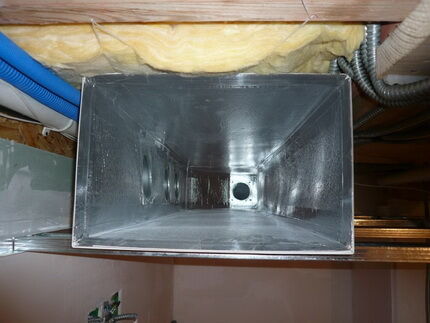
Channels for the movement of air masses
A duct-type heating system will not be able to operate without a network of air ducts. Along them, air masses move into the premises and return to the heat generator. Circular transportation is most often used, since single-pipe structures, which can also be used, have limited functionality and a large number of disadvantages. In the drawing, this design resembles two trees.
The role of the trunks is played by two rigid main pipelines made of galvanized metal. One of them is the feeder, the second is the return. “Branches” are connected to them through adapters.
These are flexible air ducts of a smaller cross-section that extend to the rooms. They must be sealed with aluminum tape and insulated. Insulation in this case not only retains heat, but also absorbs sounds.
For insulation, as a rule, foil insulation of different brands is used. For highways, a coating with a thickness of 3 to 10 mm is selected. For distribution channels, material with a thickness of 25-30 mm is suitable.
Inside single-story buildings, heated air is directed from bottom to top, so air ducts can be built into the floor. In two-story buildings, a network of air ducts can be laid along the ceiling of the first floor or in the thickness of the interfloor ceiling.
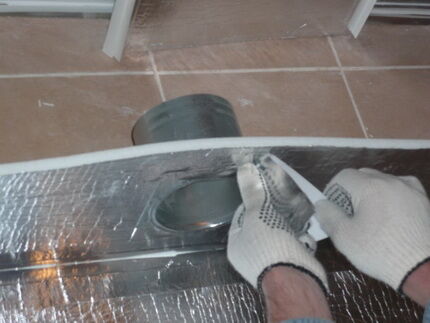
In this case, hot air is supplied to the first floor from the ceiling. Air duct outlets on the second floor are located at the bottom of the interior walls and on the floor. The return line is also placed differently.
On the ground floor, openings for collecting cooled air are located at floor level. On the second, on the contrary, near the ceiling. Superheated air masses collect here and enter the return line.
Fans for air circulation
Air masses inside pipelines are transported forcibly. This operation is carried out by special duct type fans. The equipment is installed on both return and supply air ducts. In addition, most often they are also structural elements of the air heater.
When choosing a fan, in addition to technical characteristics, it is advisable to take into account the following parameters:
- ability to work at different speeds;
- minimum noise level;
- lack of sensitivity to voltage changes;
- equipped with a soft start system;
- possibility of smooth adjustment of equipment speed.
You need to understand that fans are responsible for the pressure performance of the equipment, in fact, they determine it. Therefore, the technical parameters of the equipment must precisely correspond to the specifics of a particular system.

Flow distribution: grilles and diffusers
All air ducts suitable for the room are connected to ventilation grilles or diffusers.These elements are intended to separate air flows intended for heating, ventilation and air conditioning, as well as to uniformly distribute air flows indoors.
Floor, wall and ceiling devices are produced, among which you can find models with movable adjustable blinds.
In-channel dampers and valves
The elements are designed to adjust the throughput of the heating system. Throttle valves must be installed in the supply air ducts. The devices regulate the pressure of air masses entering different rooms and make it possible to fix it if necessary.
Various sections of air ducts are equipped with valves. It is mandatory to install supply valves that regulate the flow of air from the street.
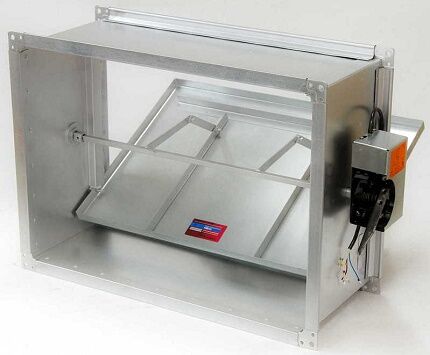
Air preparation equipment
Considering that air heating is often combined with air conditioning systems, air preparation is becoming a popular option. In this case, the design is equipped with various filters: carbon, mechanical, electrostatic.
They purify the air of all kinds of impurities. Additionally, humidifiers, ionizers, ventilation anemostats, sterilizers, dehumidifiers and similar equipment.
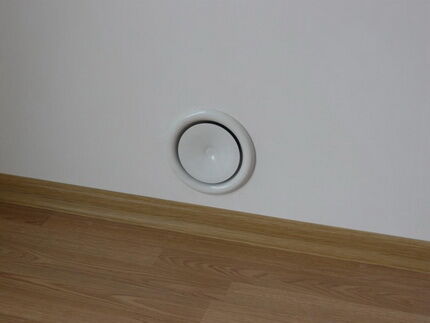
Automatic control systems
Air heating in itself, and especially combined with ventilation and air conditioning, is considered a rather complex system. To coordinate its functioning, automatic control units are used, which make it possible to quickly and accurately change the system’s operating parameters.
If necessary, the owner can set the characteristics he needs, obtaining the most comfortable microclimate for him in the house.
Control units differ in functionality and are selected individually for each specific heating system. Properly selected automation allows you not only to fully control the air heating, but also to change the settings included in the program at a distance, distribute air flows in a zoned manner and turn on the heating in the smart home system.
Features of carrying out competent calculations
Despite the assurances of would-be experts, it is very difficult to independently calculate air heating. Only specialists can do this task.
The customer can only check the availability of all project items, which include:
- Determination of heat losses for each heated room.
- Type of heating equipment indicating the required power, which should be calculated based on actual heat loss.
- The required amount of heated air, taking into account the power of the selected heating device.
- Required cross-section of air ducts, their length, etc.
These are the main points for calculating the heating system. It would be right to order a project from specialists. As a result, the customer will receive several calculation options from which he can choose and implement the solution he likes best.

Conclusions and useful video on the topic
Why choose air heating:
How to calculate the air heating system yourself:
Basics of arranging air heating in a private house:
Air heating is one of the safe, economical, extremely durable and reliable systems. That is why it is becoming more and more in demand. It’s quite easy to set up the system yourself, but it’s unlikely to be possible to carry out competent calculations.
Possible errors will lead to a decrease in the efficiency of the system, constant drafts and other unpleasant consequences. It is optimal to receive a professionally prepared project and, if desired, bring it to life with your own hands.
Do you want to share interesting facts about the construction of air heating or talk about the use of the system? Do you have questions or complaints about the information provided? Please write comments in the block below.




The air heating system has many advantages, but there are also a lot of disadvantages. First of all, the calculation and installation of such a system is possible only at the stage of construction of a house or structure. Also, for normal functioning, such a system requires a constant supply of electricity, which means a backup power source is needed. Well, it is difficult to change or improve the air heating system during operation.
I'm interested in air heating, but I'm confused by the dust that moves with the air. My wife is asthmatic and I’m not sure that this is harmless to health. Tell me, is this so?
In systems of this type, filters are used on return air ducts, mechanical (the cleaning class depends on the type of filter) and electrostatic (collects very small particles), and ultraviolet sterilizers are also installed. So with such a system the air will be much cleaner, unlike underfloor heating or radiators.
If you install good filters, then there will be no dust pollution in the house. For air heating there is a whole system of filters: a coarse filter, an electrostatic filter, an electronic one. For the latter, after a certain period of operation, the carbon filter element will need to be replaced. Keep an eye on the indicators, which should light up when replacement is required.
A friend of mine suffers from asthma, but the filter system installed in the house with air heating allows her to breathe clean air and not experience discomfort.
How many cubic meters of gas are required to heat 100 square meters? up to 20 degrees?